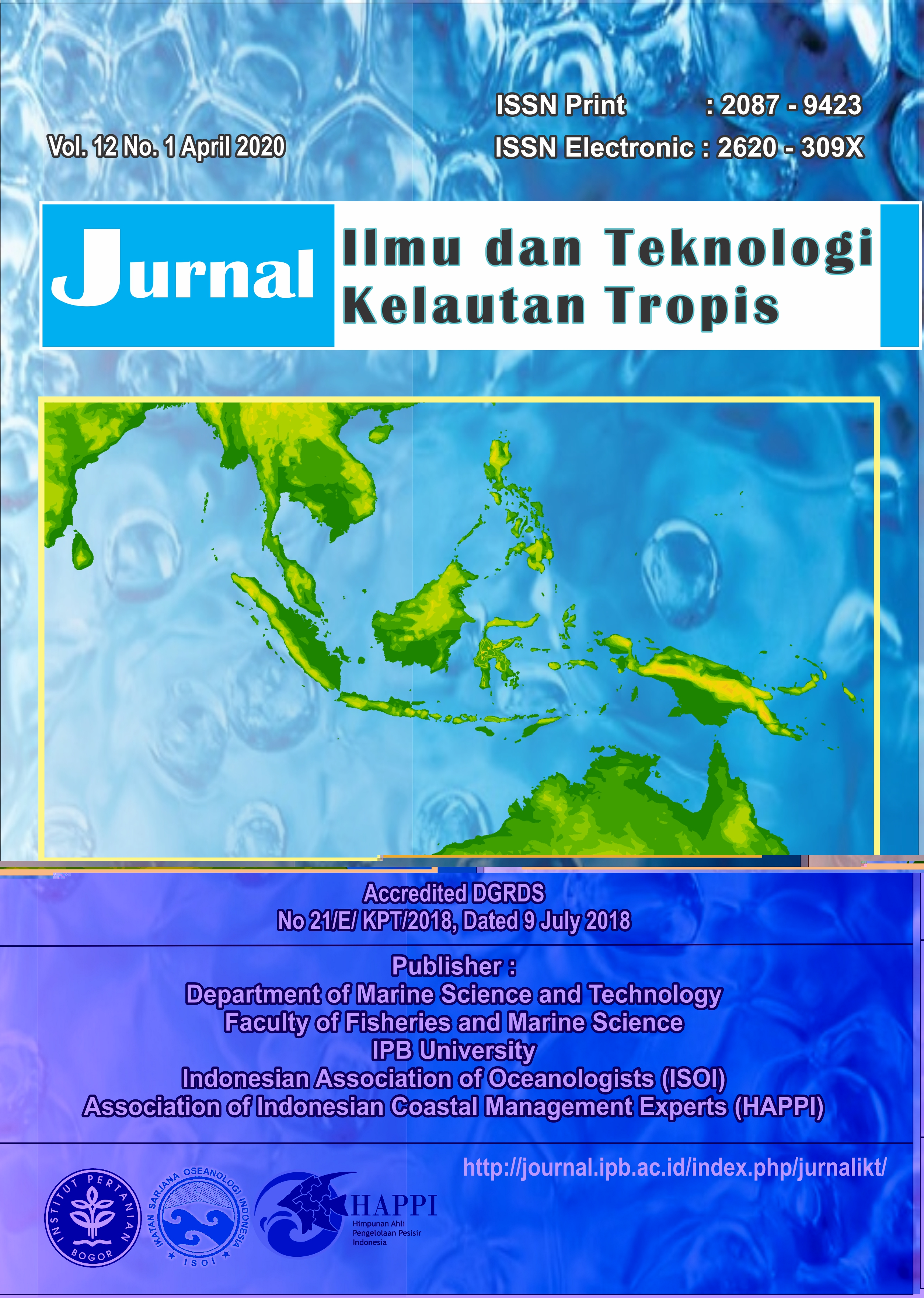RESPONS SUHU PERMUKAAN LAUT DAN KLOROFIL-A TERHADAP KEJADIAN ENSO DAN IODM DI WILAYAH INDO-PASIFIK TROPIS
Abstrak
Fenomena anomali laut-atmosfer antar-tahunan dari El Nino Southern Oscillation (ENSO) dan Indian Ocean Dipole Mode (IODM) di wilayah Indo-Pasifik Tropis memberikan dampak pada ekosistem laut, hidrologi dan variabilitas iklim. Penelitian ini bertujuan untuk menganalisis pola spasial dan variabilitas temporal suhu permukaan laut (SPL) dan klorofil-a permukaan (Chl-a) terkait dengan ENSO dan IODM di Indo-Pasifik Tropis. Data deret waktu bulanan dari tahun 1980-2017 (37 tahun) diperoleh dari pusat data global, dan dianalisis menggunakan metode empirical orthogonal function (EOF). Hasil penelitian menunjukkan nilai tiga terbesar pertama dari SPL (Chl-a) menjelaskan 81,7% (76%) dari total explained variance. Struktur spasial SPL mode-1 (56%) membentuk seperti dua kutub asimetris antara timur dan barat Pasifik Tropis dengan pola yang berbeda di lepas Pantai Peru. Pola ini diduga berhubungan dengan tahun normal atau La Nina. Selanjutnya, kondisi EL Nino dan IODM diduga tergambarkan oleh SPL mode-2 (19%), dengan fase negatif dominan di atas ekuator Pasifik dan menghilangnya area upwelling di lepas Pantai Peru.
Referensi
Behera, S.K., J.J. Luo, S. Masson, S.A. Rao, & H. Sakuma. 2006. A CGCM study on the interaction between IOD and ENSO. J. of Climate, 19: 1688–1705. https://doi.org/10.1175/JCLI3797.1
Bendat, J.S. & A.G. Piersol. 1971. Random data analysis and measurement procedure. John Wiley and Sons Inc. New York. 366 p.
Bjerknes, J., 1969. Atmospheric teleconnections from the equatorial Pacific, Mon. Weather Rev., 97, 163–172 pp.
Bracco, A., F. Kucharski, F. Molteni W. Hazeleger, & C. Severijns. 2007. Atmospheric for simulating the interannual variability of the Asian summer monsoon and its relation with ENSO. Clim. Dyn., 28(5): 441–460. https://doi.org/10.1007/s00382-006-0190-0
Eisenman, I., L. Yu, & E. Tziperman. 2005. Westerly Wind Burst: ENSO’s Tail Rather than the Dog?. J. Climate, 10: 5224-5238. http://doi.org/10.1175/JCLI3588.1
Hannachi, A. 2004. A primer for eof analysis of climate data. Department of Meteorology, University of Reading Reading RG6 6BB, U.K. 33 p. https://pdfs.semanticscholar.org/f492/b48483c83f70b8e6774d3cc88bec918ab630.pdf
Kug, J.S., S.I. An, F.F. Jin, & I.S. Kang. 2005. Preconditions for El Niño and La Niña onsets and their relation to the Indian Ocean. Geophys. Res. Lett., 32(L05706): 1-5. https://doi.org/10.1029/2004GL021674
McBride, J.L., M.R. Haylock, & N. Nicholls. 2003. Relationship between the Maritime Continent Heat Source and the El Nino-Southern Oscillation Phenomenon. J. of Climate, 16: 2905-2914. https://doi.org/10.1175/1520-0442(2003)016<2905:RBTMCH>2.0.CO;2
Meehl, G.A. & J.M. Arblaster. 2011. Decadal variability of Asian-Australian Monsoon-ENSO-TBO Relationships. J. Climate, 24: 4925-4940. http://doi.org/10.1175/2011JCLI4015.1
Purwandani, A. 2012. Variability of sea surface temperature and its inter-relationships with the monsoon, Dipole Mode (DM) and El Nino Southern Oscillation (ENSO) in the Southeast Asia and its surrounding water. Bogor Agricultural University. Indonesia. 425 p.
Saji, N.H., B.N. Goswani, P.N. Vinayachandran, & T. Yamagata. 1999. A Dipole mode in the tropical Indian Ocean. Nature, 401: 360-363. https://doi.org/10.1038/43854
Tjasyono, B. 1997. Mekanisme fisis pra, selama, dan pasca El Niño. Paper disajikan pada Workshop kelompok peneliti dinamika atmosfer, 13-14 Maret 1997. 15 p.
Torrence, C. & G.P. Compo. 1998. A practical guide to wavelet analysis. User guide. Colorado University. 18 p.
Walker, G.T. 1923. Correlation in seasonal variations of weather, VIII: A preliminary study of world weather. memoirs of Indian Meteorological Department, 24: 75-131 pp.
Webster, P.J., A.M. Moore, J.P. Loschnigg, & R.R. Leben. 1999. Coupled ocean–atmosphere dynamics in the Indian Ocean during 1997–98. Nature, 401: 356–360. https://doi.org/10.1038/43848
Yamagata, T., S.K. Behera, S.A. Rao, Z. Guan, K. Ashok, & H.N. Saji. 2002. The Indian Ocean Dipole: A physical entity. CLIVAR Exch., 24: 15–18.
Yoon, J. & S.W. Yeh. 2010. Influence of the Pacific Decadal Oscillation on the Relationship between El Nino and the Northeast Asian Summer Monsoon. J. Climate, 23: 4525-4537. https://doi.org/10.1175/2010JCLI3352.1
Yuan, D.L., J. Wang, T.F. Xu, P. Xu, Z. Hui, X. Zhao, Y.H. Luan, W.P. Zheng, & Y.Q. Yu. 2011. Forcing of the Indian Ocean dipole on the interannual variations of the tropical Pacific Ocean: roles of the Indonesian Throughflow. J. Climate, 24(14): 3593–3608. https://doi.org/10.1175/2011JCLI3649.1
Penulis
The author submitting the manuscript must understand and agree that the copyright of the article manuscript must be submitted/transferred to the Jurnal Ilmu dan Teknologi Kelautan Tropis. This work is licensed under the Creative Commons Attribution-ShareAlike 4.0 (CC BY-SA) International License in which the Author and Reader can copy and redistribute the material in any media or format, and remix, modify and build material for any purpose, but they must provide appropriate credit (citing articles or content), provide a link to the license, and indicate whether there is a change. If you mix, change, or create material, you must distribute your contribution under the same license as the original.


